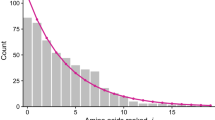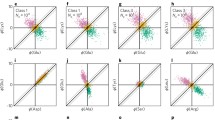Abstract
Neutral evolution is the simplest model of molecular evolution and thus it is most amenable to a comprehensive theoretical investigation. In this paper, we characterize the statistical properties of neutral evolution of proteins under the requirement that the native state remains thermodynamically stable, and compare them to the ones of Kimura’s model of neutral evolution. Our study is based on the Structurally Constrained Neutral (SCN) model which we recently proposed. We show that, in the SCN model, the substitution rate decreases as longer time intervals are considered. Fluctuations from one branch of the evolutionary tree to another are strong, leading to a non-Poissonian statistics for the substitution process. Such strong fluctuations are in part due to the fact that neutral substitution rates for individual residues are strongly correlated for most residue pairs. Interestingly, structurally conserved residues, characterized by a much below average substitution rate, are also much less correlated to other residues and evolve in a much more regular way. Our results can improve methods aimed at distinguishing between neutral and adaptive substitutions as well as methods for computing the expected number of substitutions occurred since the divergence of two protein sequences. In particular, we compute the minimal sequence similarity below which no information about the evolutionary divergence of the compared sequences can be obtained.
Similar content being viewed by others
References
VI Abkevich AM Gutin EI Shakhnovich (1994) ArticleTitleFree energy landscapes for protein folding kinetics—intermediates, traps and multiple pathways in theory and lattice model simulations. J Chem Phys 101 6052–6062 Occurrence Handle10.1063/1.467320 Occurrence Handle1:CAS:528:DyaK2cXmvFGgur4%3D
A Babajide IL Hofacker MJ Sippl PF Stadler (1997) ArticleTitleNeutral networks in protein space. Fol Des 2 261–269 Occurrence Handle1:CAS:528:DyaK2sXntVKqurg%3D
U Bastolla J Farwer EW Knapp M Vendruscolo (2001) ArticleTitleHow to guarantee optimal stability for most representative structures in the protein data bank. Proteins 44 79–96 Occurrence Handle10.1002/prot.1075 Occurrence Handle1:CAS:528:DC%2BD3MXkvVaktLk%3D Occurrence Handle11391771
U Bastolla HE Roman M Vendruscolo (1999) ArticleTitleNeutral evolution of model proteins: Diffusion in sequence space and overdispersion. J Theor Biol 200 49–64 Occurrence Handle10.1006/jtbi.1999.0975 Occurrence Handle1:CAS:528:DyaK1MXlslemsr4%3D Occurrence Handle10479539
U Bastolla M Porto HE Roman M Vendruscolo (2003) ArticleTitleConnectivity of neutral networks, overdispersion and structural conservation in protein evolution. J Mol Evol 56 243–254 Occurrence Handle10.1007/s00239-002-2350-0 Occurrence Handle1:CAS:528:DC%2BD3sXhslWiu7g%3D Occurrence Handle12612828
U Bastolla M Porto HE Roman M Vendruscolo (2002) ArticleTitleLack of self-averaging in neutral evolution of proteins. Phys Rev Lett 89 20181/1–4 Occurrence Handle10.1103/PhysRevLett.89.208101
U Bastolla M Vendruscolo HE Roman (2000b) ArticleTitleStructurally constrained protein evolution: Results from a lattice simulation. Eur Phys J B 15 385–397 Occurrence Handle1:CAS:528:DC%2BD3cXktFalsLk%3D
U Bastolla M Vendruscolo EW Knapp (2000a) ArticleTitleA statistical mechanical method to optimize energy functions for protein folding. Proc Natl Acad Sci USA 97 3977–3981 Occurrence Handle1:CAS:528:DC%2BD3cXislSgt78%3D
E Bornberg-Bauer (1997) ArticleTitleHow are model protein structures distributed in sequence space? Biophys J 73 2393–2403 Occurrence Handle1:CAS:528:DyaK2sXntFyltr4%3D Occurrence Handle9370433
E Bornberg-Bauer HS Chan (1999) ArticleTitleModeling evolutionary landscapes: Mutational stability, topology, and superfunnels in sequence space. Proc Natl Acad Sci USA 96 10689–10694 Occurrence Handle10.1073/pnas.96.19.10689 Occurrence Handle1:CAS:528:DyaK1MXmtFKjsr4%3D Occurrence Handle10485887
JU Bowie R Lüthy D Eisenberg (1991) ArticleTitleA method to identify protein sequences that fold into a known 3-dimensional structure. Science 253 164–170 Occurrence Handle1:CAS:528:DyaK3MXltV2qsbk%3D Occurrence Handle1853201
RJ Britten (1986) ArticleTitleRates of DNA sequence evolution differ between taxonomic groups. Science 231 1393–1398 Occurrence Handle3082006
HJ Bussemaker D Thirumalai JK Bhattacharjee (1997) ArticleTitleThermodynamic stability of folded proteins against mutations. Phys Rev Lett 79 3530–3533 Occurrence Handle10.1103/PhysRevLett.79.3530 Occurrence Handle1:CAS:528:DyaK2sXntFGntLo%3D
NV Dokholyan EI Shakhnovich (2001) ArticleTitleUnderstanding hierarchical protein evolution from first principles. J Mol Biol 312 289–307 Occurrence Handle10.1006/jmbi.2001.4949 Occurrence Handle1:CAS:528:DC%2BD3MXmsFyht7w%3D Occurrence Handle11545603
JC Fay GJ Wyckoff C-I Wu (2002) ArticleTitleTesting the neutral theory of molecular evolution with genomic data from Drosophila. Nature 415 1024–1026 Occurrence Handle10.1038/4151024a Occurrence Handle11875569
W Fontana P Schuster (1998) ArticleTitleContinuity in evolution: On the nature of transitions. Science 280 1451–1455 Occurrence Handle10.1126/science.280.5368.1451 Occurrence Handle9603737
JH Gillespie (1991) The causes of molecular evolution. Oxford University Press Oxford, UK
JH Gillespie (1989) ArticleTitleLineage effects and the index of dispersion of molecular evolution. Mol Biol Evol 6 636–647 Occurrence Handle1:CAS:528:DyaK3cXhvVGgtw%3D%3D Occurrence Handle2488476
RA Goldstein ZA Luthey-Schulten PG Wolynes (1992) ArticleTitleOptimal protein-folding codes from spin-glass theory. Proc Natl Acad Sci USA 89 4918–4922 Occurrence Handle1:CAS:528:DyaK38Xks1GqtL0%3D Occurrence Handle1594594
S Govindarajan RA Goldstein (1997) ArticleTitleThe foldability landscape of model proteins. Biopolymers 42 427–438 Occurrence Handle10.1002/(SICI)1097-0282(19971005)42:4<427::AID-BIP6>3.0.CO;2-S Occurrence Handle1:CAS:528:DyaK2sXlvFSitLc%3D Occurrence Handle9283292
S Govindarajan RA Goldstein (1998) ArticleTitleOn the thermodynamic hypothesis of protein folding. Prod Natl Acad Sci USA 95 5545–5549 Occurrence Handle10.1073/pnas.95.10.5545 Occurrence Handle1:CAS:528:DyaK1cXjtFWktLs%3D
AM Gutin VI Abkevich EI Shakhnovich (1995) ArticleTitle. Proc Natl Acad Sci USA 92 1282–1286 Occurrence Handle1:CAS:528:DyaK2MXktFWksb4%3D Occurrence Handle7877968
U Hobohm C Sander (1994) ArticleTitleEnlarged representative set of protein structure. Protein Sci 3 522–524 Occurrence Handle1:CAS:528:DyaK2cXmsVyrsr4%3D Occurrence Handle8019422
L Holm C Sander (1996) ArticleTitleMapping the protein universe. Science 273 595–602 Occurrence Handle1:CAS:528:DyaK28Xks1ynt7w%3D Occurrence Handle8662544
MA Huynen PF Stadler W Fontana (1996) ArticleTitleSmoothness within ruggedness: The role of neutrality in adaptation. Proc Natl Acad Sci USA 93 397–401 Occurrence Handle10.1073/pnas.93.1.397 Occurrence Handle1:CAS:528:DyaK28Xjslymug%3D%3D Occurrence Handle8552647
M Kimura (1968) ArticleTitleEvolutionary rate at the molecular level. Nature 217 624–626 Occurrence Handle5637732
M Kimura (1977) ArticleTitlePreponderance of synonymous changes as evidence for the neutral theory of molecular evolution. Nature 267 275–276 Occurrence Handle1:STN:280:CSiC1M3jvFc%3D Occurrence Handle865622
M Kimura (1983) The neutral theory of molecular evolution. Cambridge University Press .
J-L King TH Jukes (1969) ArticleTitleNon-Darwinian evolution. Science 164 788–798 Occurrence Handle1:CAS:528:DyaF1MXktFyks7s%3D Occurrence Handle5767777
C-H Langley WM Fitch (1974) ArticleTitleAn estimation of the constancy of the rate of molecular evolution. J Mol Evol 3 161–177 Occurrence Handle1:CAS:528:DyaE2cXltlWku7c%3D Occurrence Handle4368400
WH Li M Tanimura PM Sharp (1987) ArticleTitleAn evaluation of the molecular clock hypothesis using mammalian DNA sequences. J Mol Evol 25 330–342 Occurrence Handle1:CAS:528:DyaL2sXlslSku78%3D Occurrence Handle3118047
D Graur WH Li (2000) Fundamentals of molecular evolution. Sinauer Sunderland, MA
J McDonald M Kreitman (1991) ArticleTitleAdaptive evolution at the Adh locus in Drosophila. Nature 351 652–654 Occurrence Handle1:CAS:528:DyaK3MXks1yrtLs%3D Occurrence Handle1904993
LA Mirny EI Shakhnovich (1996) ArticleTitleHow to derive a protein folding potential? A new approach to an old problem. J Mol Biol 264 1164–1179 Occurrence Handle10.1006/jmbi.1996.0704 Occurrence Handle1:CAS:528:DyaK2sXnt12h Occurrence Handle9000638
LA Mirny EI Shakhnovich (1999) ArticleTitleUniversally conserved positions in protein folds: Reading evolutionary signals about stability, folding kinetics, and function. J Mol Biol 291 177–196 Occurrence Handle10.1006/jmbi.1999.2911 Occurrence Handle1:CAS:528:DyaK1MXkvFKjtLY%3D Occurrence Handle10438614
M Nei S Kumar (2000) Molecular evolution and phylogenetics. Oxford University Press Oxford, UK
T Ohta (1973) ArticleTitleSlightly deleterious mutant substitutions in evolution. Nature 246 96–98 Occurrence Handle10.1073/pnas.97.20.10866 Occurrence Handle1:CAS:528:DC%2BD3cXnt1ahs7o%3D Occurrence Handle11005860
T Ohta (1976) ArticleTitleRole of very slightly deleterious mutations in molecular evolution and polymorphism. Theor Pop Biol 10 254–275 Occurrence Handle1:STN:280:CSiC3cris1M%3D
T Ohta M Kimura (1971) ArticleTitleOn the constancy of the evolutionary rate of cistrons. J Mol Evol 1 18–25 Occurrence Handle1:CAS:528:DyaE38XmvFeitw%3D%3D Occurrence Handle4377445
MF Perutz JC Kendrew HC Watson (1965) ArticleTitleStructure and function of Haemoglobin: Some relations between polypeptide chain configuration and amino acid sequence. J Mol Biol 13 669–678 Occurrence Handle1:CAS:528:DyaF28XltV2m
OB Ptitsyn KH Ting (1999) ArticleTitleNon-functional conserved residues in globins and their possible role as a folding nucleus. J Mol Biol 291 671–682 Occurrence Handle10.1006/jmbi.1999.2920 Occurrence Handle1:CAS:528:DyaK1MXltFShs7k%3D Occurrence Handle10448045
B Rost (1997) ArticleTitleProtein structures sustain evolutionary drift. Fol Des 2 S19–S24 Occurrence Handle1:CAS:528:DyaK2sXktlCgtb4%3D
N Saitou M Nei (1987) ArticleTitleThe neighbor-joining method—a new method for reconstructing phylogenetic trees. Mol Biol Evol 4 406–425 Occurrence Handle1:STN:280:BieC1cbgtVY%3D Occurrence Handle3447015
NGC Smith A Eyre-Walker (2002) ArticleTitleAdaptive protein evolution in Drosophila. Nature 415 1022–1024 Occurrence Handle10.1038/4151022a Occurrence Handle1:CAS:528:DC%2BD38XhvVWjsLs%3D Occurrence Handle11875568
P Schuster W Fontana PF Stadler IL Hofacker (1994) ArticleTitleFrom sequences to shapes and back—A case-study in RNA secondary structures. Proc R Soc Lond B 255 279–284 Occurrence Handle7517565
E Shakhnovich V Abkevich O Ptitsyn (1996) ArticleTitleConserved residues and the mechanism of protein folding. Nature 379 96–98 Occurrence Handle10.1038/379096a0 Occurrence Handle1:CAS:528:DyaK28XivVKnsg%3D%3D Occurrence Handle8538750
N Takahata (1987) ArticleTitleOn the overdispersed molecular clock. Genetics 116 169–179 Occurrence Handle1:STN:280:BiiB2cfgtlI%3D Occurrence Handle3596230
G Tiana RA Broglia HE Roman E Vigezzi EI Shakhnovich (1998) ArticleTitleFolding and misfolding of designed proteinlike chains with mutations. J Chem Phys 108 757–761 Occurrence Handle10.1063/1.475435 Occurrence Handle1:CAS:528:DyaK1cXhvF2ltw%3D%3D
JD Thompson DG Higgins TJ Gibson W Clustal (1994) ArticleTitleImproving the sensitivity of progressive multiple sequence alignment through sequence weighting, position-specific gap penalties, and weight matrix choice. Nucleic Acids Res 22 4673–4680 Occurrence Handle7984417
T Uzzell K Corbin (1971) ArticleTitleFitting discrete probability distributions to evolutionary events. Science 172 1089–1096 Occurrence Handle1:CAS:528:DyaE3MXksVCktL4%3D Occurrence Handle5574514
Y Xia M Levitt (2002) ArticleTitleRoles of mutation and recombination in the evolution of protein thermodynamics. Proc Natl Acad Sci USA 99 10382–10387 Occurrence Handle10.1073/pnas.162097799 Occurrence Handle1:CAS:528:DC%2BD38Xmt1Ciu74%3D Occurrence Handle12149452
E Zuckerkandl L Pauling (1962) Molecular disease, evolution and genetic heterogenity. M Kasha B Pullman (Eds) Horizons in biochemistry. Academic Press New York 189–225
Author information
Authors and Affiliations
Corresponding author
Rights and permissions
About this article
Cite this article
Bastolla, U., Porto, M., Eduardo Roman, H. et al. Statistical Properties of Neutral Evolution . J Mol Evol 57 (Suppl 1), S103–S119 (2003). https://doi.org/10.1007/s00239-003-0013-4
Received:
Accepted:
Issue Date:
DOI: https://doi.org/10.1007/s00239-003-0013-4




